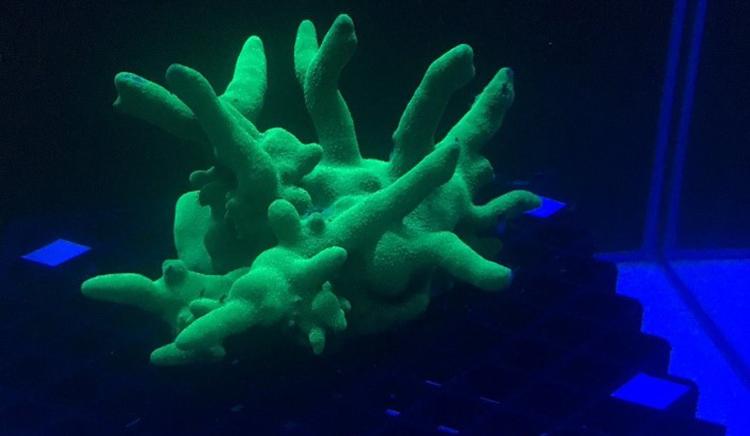
Coral (Montipora digitata) displaying a bright green fluorescence under royal blue (440 nm) LED excitation light source. (Credit J. Teague)
Climate change manifests itself in many ways, and affects all parts of the globe. One particularly striking manifestation is the “bleaching” of corals. We frequently hear reports that large parts of the Great Barrier Reef have undergone bleaching, but many other areas where corals live are also affected.
Corals live in a symbiosis with photosynthetic algae called Zooxanthellae. These algae benefit from nutrients and protection from the coral, whilst providing it with energy from their photosynthesis. Coral bleaching is triggered by a number of stressors such as increased water temperature and ocean acidification, the main causes are linked with climate change. During the process of bleaching, corals expel the Zooxanthellae as a fight or flight type response. The main constituents of coral colour are attributed to Zooxanthellae, hence in their absence the coral turns white (or bleaches), which is the colour of the calcium carbonate skeleton being exposed.
Coral reefs are of significant value through the protection they offer to coasts, the livelihoods and food security they offer, and through the tourism they attract. Detection of the early onset of coral diseases and bleaching is important for their mitigation. However, monitoring of reefs is expensive, for high-resolution surveys rely on divers who can only cover relatively small areas, need to be experienced and who may not be able to work as often as required. Larger areas can be covered using satellites, but at the expense of spatial and spectral resolution. This proposed technique aims to improve on the shortcomings of both approaches and complement them.
Corals and the Zooxanthellae contain naturally fluorescent proteins (FPs) as well as chlorophyll, which has a well-established fluorescence emission. The presence of FPs can be used as a marker of coral health and the presence of the chlorophyll-rich Zooxanthellae for the absence of bleaching. Work reported in JSI—Journal of Spectral Imaging (https://doi.org/10.1255/jsi.2019.a7) from Jonathan Teague and colleagues at the University of Bristol, UK, and Sealife London Aquarium offers a possible solution through the use an underwater remotely operated vehicle (ROV) equipped with a fluorescence hyperspectral imaging camera.
The authors have shown that the optimum excitation for corals’ FPs is in the UV and blue (395–405 nm and 440 nm). This provides sufficient energy to excite corals at a reasonable distance (approximately 1 m) and high enough power to mitigate against the effects of light absorption by seawater. They propose the use of a portable, fully waterproof, low-cost hyperspectral imaging system that can be mounted on the ROV, which can be driven over a reef to provide a map of the natural fluorescence. This is analogous to the use of a drone with a hyperspectral camera in precision agriculture to map crops in fields. The authors hope to start testing such a system over a coral reef in the next few months.
